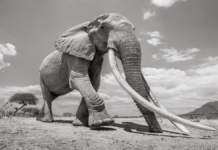Ribbon Seals are one of the most easily recognizable and striking seals in this world. Ribbon seals have got their name because of the adult coat pattern of light color ribbons on a dark background. Their habitats are spread over the Southern parts of the Arctic Ocean and North Pacific Ocean. In U.S. waters, ribbon seals can be found off the coast of Chukchi, the western Beaufort Seas, and on the coast of Alaska in the Bering Sea.

These ribbon seals are known as solitary animal species. They spend most of their time in the open sea and during spring, they form loose aggregations on pack ice to give birth to new babies and to nurse them. They are very sensitive to changes in the environment. Specially for the extent and timing of sea ice formation and breakup.

It is very difficult to estimate the total number of ribbon seals around the world accurately. But according to the scientists who have conducted various research regarding their population, there is a range-wide population of ribbon seals around 200,000 to 300,000. Even though it has become difficult to determine the current population trend of them. But there were strong upward and downward trends during the recent past.
When considering history, the subsistence harvest of the ribbon seals has been very low. In the United States, commercial harvest of marine mammals is not allowed. But it was permitted in the Russian Federation. Commercial harvests done by Russian sealers had caused a significant reduction in the ribbon seal population. But after 1994, commercial harvests of ribbon seals remained very low.
As mentioned before ribbon seals have got their name because of the attractive pattern found in mature individuals that consist light color ribbons around the neck, fore flippers and hips. Adult males have the most striking pattern with white ribbons in dark brown to black coats. Female adults have paler ribbons in silvery-gray to dark brown coats. Juvenile ribbon seals have some indistinct ribbons that gradually develop with successive annual molts over 3 years. When ribbon seal puppies are born, they have a thick wooly white coat that will be molted after 3-5 weeks.

When compared with the three ice-associated seal species in the North Pacific, ribbon seals are medium-sized. They are smaller than bearded seals, larger than ringed seals and in similar size to spotted seals. At birth, ribbon seal puppies weigh around 21 pounds and their length is around 34 inches. Adult ribbon seals weigh around 200-300 pounds and their length is around 5-6 feet.
When talking about the behavior of ribbon seals, they are relatively solitary and spend most of the time forming loose aggregations in pack ice and Open Ocean. They are relatively unaware of their surroundings while hauled out, unlike other northern seals. It means that they have not been exposed to a huge level of predation like foxes and polar bears.
Ribbon seals use a different method than other seals while moving across the ice. While other seal species have a caterpillar-like movement, ribbon seals use their alternate fore flipper strokes to pull themselves forward and while going forward, they move their hips and head in a side-to-side motion. They eat a large variety of food items. It includes fishes, crustaceans and cephalopods. However further information about their feeding habits is very limited and it is restricted to the spring when they usually feed less.
The ribbon seals are inhabited in southern parts of the Arctic Ocean such as the Bering Sea, the sea of Okhotsk, and in the North Pacific Ocean. In U.S. waters off the coast of Alaska, ribbon seals can be found in the western Beaufort Sea, Bering Sea, and in Chukchi. Their breeding happens in the Sea of Okhotsk and in the Bering Sea. And also these ribbon seals are very associated with sea ice during their molting periods and breeding periods. They usually do not remain on ice after finishing their molting. Ice completely melts in the sea of Okhotsk during the summer and by that time ice of the Bering Sea recedes to the North through the Bering Strait. During that time only a small number of ribbon seals can be seen hauling out on the ice. When the sea ice reforms in winter, then only we can see a significant number of ribbon seals in the area.

Sometimes ribbon seals have occasionally been sighted in the coasts of North America and Asia. It is not a usual part of their rage. For example, an adult ribbon seal was observed several times at the docks in the inland waters of Washington State.
The usual lifespan of a ribbon seal is around 20 years and the maximum is around 30 years. But information about their reproduction and survival is not known well. Usually, ribbon seals become sexually mature between 1-5 years of age and it highly depends on the environmental conditions. A Female ribbon seal gives birth to a single baby during April and early may after 5-6 weeks of mating. Most of the time female ribbon seals abandon their pups and those pups are being weaned by mid-May.
One of the major threat ribbon seals have is changes in the climate. As discussed previously, ribbon seals heavily rely on sea ice. It is necessary to have the availability of suitable sea ice for their molting and breeding. But according to a status review done in 2013, ongoing and projected changes in sea ice resulted in a gradual decline in seal abundance.
In recent years, the interest in using the Arctic Ocean for marine operations has increased. The intensity of shipping activities, and offshore gas and oil explorations have also become threats to the ribbon seals.

















